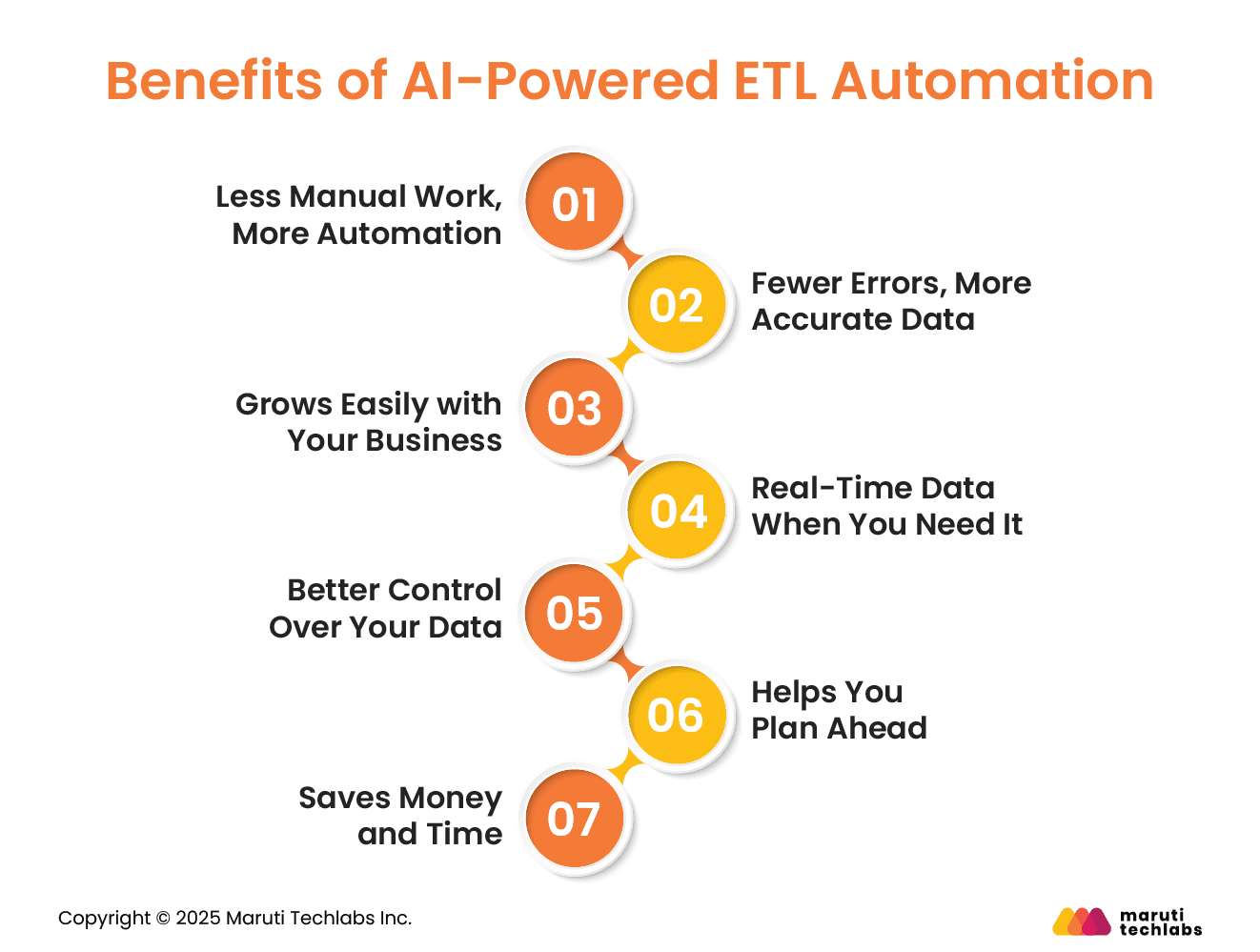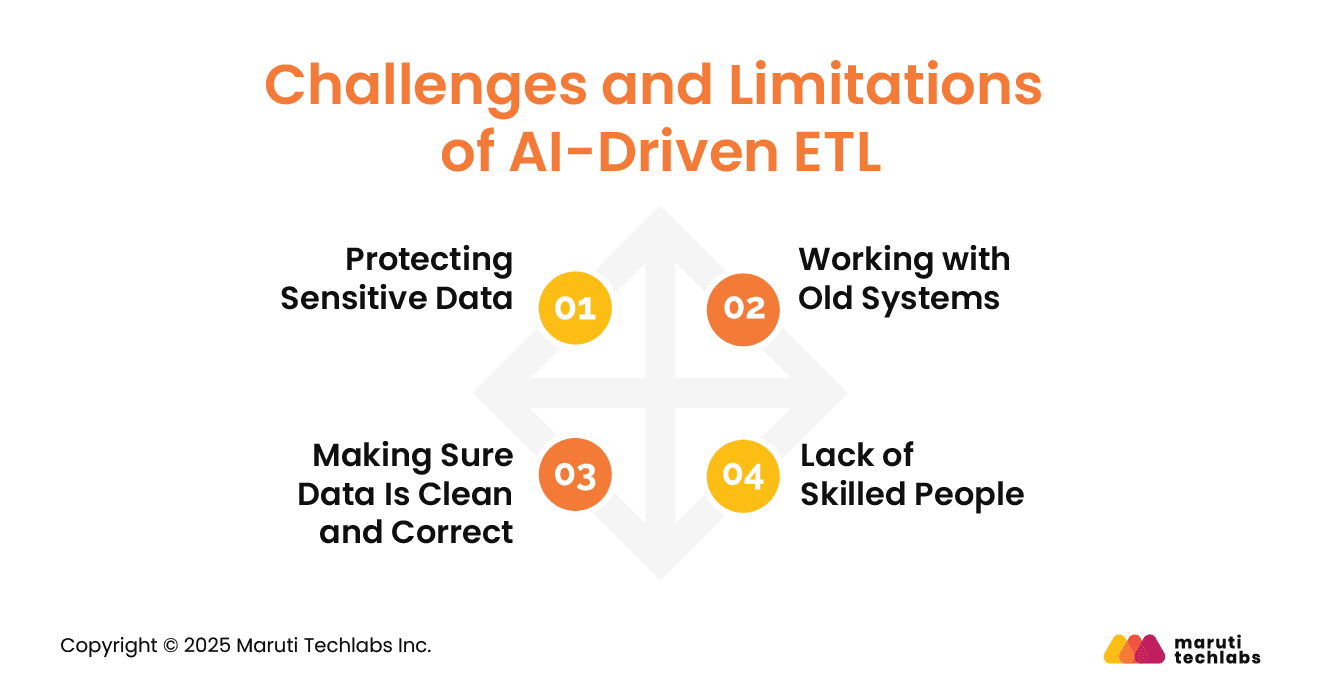

Making ETL Smarter with AI: A Practical Guide for Teams






ETL, or Extract, Transform, Load, has long been a key method for combining and preparing data from multiple sources for analytics, reporting, and machine learning. However, traditional ETL processes are often slow to develop, complex to maintain, and struggle with real-time processing, unstructured data, and scalability. They rely heavily on manual scripting and scheduled batch processing, which creates delays and increases maintenance overhead.
As organizations deal with growing data volumes and demand real-time insights, the limitations of legacy ETL are becoming harder to ignore. Engineering teams are spending more time fixing pipelines than focusing on innovation. That’s why automation is becoming essential to reduce manual work, adapt to data diversity, and speed up delivery.
By 2025, over 80% of enterprises will rely on AI-driven automation to enhance how they ingest, transform, and analyze data. This blog covers what AI-driven ETL is, its benefits, real-world use cases, popular tools, key challenges, and what lies ahead.
AI-driven ETL is a smarter way to manage data. It uses artificial intelligence to improve the regular ETL process. Instead of relying on fixed rules and lots of manual work, it learns from data and handles tasks like mapping, cleaning, and moving data automatically. This makes the whole process quicker and easier.
Unlike standard automation, which needs fixed rules and frequent updates, AI-driven ETL adapts over time. It understands new data structures, identifies errors, and makes real-time decisions without much human help. This leads to cleaner, more reliable data with less manual effort.

One practical example is during data ingestion, where AI can apply natural language processing (NLP) to understand and classify unstructured text data, reducing manual effort and improving consistency from the start.
AI-powered ETL helps teams manage data faster, more accurately, and with less manual work. Here are some of the main benefits in plain language:

1. Less Manual Work, More Automation
AI takes care of routine tasks like pulling in data, cleaning it up, and loading it where it needs to go. This saves time and lets your team focus on more useful work, like analyzing data or making better decisions.
2. Fewer Errors, More Accurate Data
AI tools can spot mistakes, fill in missing values, and fix formatting issues automatically. This means the data you use for reports and decisions is cleaner and more reliable.
3. Grows Easily with Your Business
AI systems can handle more of your data without slowing down as your data grows. They work well with large datasets and can manage data from many different sources.
4. Real-Time Data When You Need It
Traditional tools often process data in chunks, which creates delays. AI-powered ETL can process data as it comes in, so you get real-time updates and can act quickly.
5. Better Control Over Your Data
AI helps apply data rules, such as masking private information or ensuring data is handled properly. It also helps track where data comes from and how it changes, which is essential for following privacy laws and company policies.
6. Helps You Plan Ahead
AI can study patterns in your data and help predict what might happen next. For example, it can show what products might sell more in the coming weeks or alert you about something unusual in the data.
7. Saves Money and Time
AI-powered ETL can lower costs by reducing manual work, errors, and using computer resources wisely. It also helps your team work more efficiently, which adds value over time.
AI-powered ETL is helping many industries manage their data better, work faster, and make smarter decisions. Here are a few ways it's being used in real life:
In retail and e-commerce, AI-driven ETL helps businesses understand customer behavior. It collects and organizes data from websites, apps, and sales systems to create better product recommendations and personalized marketing. This leads to higher sales and improved customer experiences.
Healthcare providers deal with huge amounts of patient data. AI-powered ETL helps clean, organize, and connect this data from different systems. For example, NHS Greater Manchester used AI tools to move its data to the cloud. This gave them complete visibility into patient records, improved operations, and supported better patient care.
Banks and financial firms use AI-driven ETL to handle large volumes of fast-moving data. It helps detect fraud by spotting unusual transaction patterns in real time. Companies like the London Stock Exchange Group used AI and cloud tools to quickly build reliable data pipelines, even after merging with other organizations.
These examples show how AI in ETL is helping industries work smarter, manage data better, and stay ahead in a data-driven world.
There are many tools available today that help automate ETL using AI. These tools make it easier to build, manage, and scale data pipelines without too much manual work. Here are some popular options:
1. Integrate.io
A low-code platform that's easy to use. It supports a wide range of data sources and is suitable for teams that want to get started quickly with cloud-based ETL and automation.
2. Airbyte
An open-source tool that’s great for building your own data connectors. It supports batch and real-time pipelines and is a strong choice for engineering teams wanting more control.
3. Fivetran
This tool focuses on fully managed data pipelines. It automatically handles schema changes and updates, making it great for companies looking for hands-off automation and fast setup.
4. Coalesce
Built for modern cloud data warehouses, Coalesce helps data teams build pipelines with strong data modeling and transformation features. It’s a good fit for teams that work heavily in SQL.
5. Hevo Data
A no-code platform that supports real-time data movement. It’s simple to set up and helps businesses keep their data fresh across systems with minimal effort.
When picking a tool, think about your team’s comfort with code, the amount of data you handle, whether you need real-time updates, and if you have to meet any specific security or compliance needs. The right tool depends on your goals, team skills, and how much control or automation you want.
While AI-driven ETL can make data work faster and smarter, it also brings some challenges that businesses should consider.

1. Protecting Sensitive Data
AI tools often process large amounts of personal or sensitive data. Strong security rules must be in place to prevent this data from falling into the wrong hands. Companies also need to follow privacy laws like GDPR or HIPAA.
2. Working with Old Systems
Many companies still use older software systems. Connecting these systems with newer, AI-powered tools can be tricky. Businesses must check if their old and new tools can work together without breaking the data flow.
3. Lack of Skilled People
AI-driven ETL tools often require people who understand both data and AI. However, not every team has these skills. Therefore, companies may need to train their current team or hire people who are already experienced with these tools.
4. Making Sure Data Is Clean and Correct
AI works best when it has clean, complete data. If the data is messy or wrong, the results will also be off. So, making sure the incoming data is good is very important for AI to work well in ETL.
AI-driven ETL is redefining how organizations manage data complexity at scale. By integrating machine learning and intelligent automation, it streamlines the extract, transform, and load process, improving efficiency, accuracy, and adaptability. As data volumes and sources grow, this approach offers a practical path to building more responsive and resilient data infrastructure.
To move forward, consider evaluating the current maturity of your ETL automation and identifying areas where AI can enhance performance. Aligning these insights with your broader data platform strategy will help you unlock long-term value from your data initiatives.
If you're looking to modernize your pipelines or explore AI-powered solutions, we’d be glad to support you. Contact us to learn more about our Data Engineering Services at Maruti Techlabs.
Additionally, to ensure your organization is truly prepared for AI integration, take advantage of our AI Readiness Assessment Tool. This practical audit evaluates your current capabilities, highlights gaps, and provides actionable recommendations to help your team successfully adopt AI-driven ETL solutions and beyond. Reach out to get started on your AI readiness journey today.
Python is not an ETL tool by itself, but it’s often used to build ETL pipelines. With libraries like Pandas and Airflow, developers can create custom ETL processes easily.
A retail company collects sales data from stores, transforms it to match reporting formats, and loads it into a data warehouse for analysis. This helps managers track daily sales, spot trends, and make better business decisions. The entire process, from collecting to analyzing data, is a common example of ETL in action.
There’s no single best ETL tool; it depends on your needs. Tools like Fivetran and Hevo are great for no-code automation. Apache Airflow and Talend are preferred for complex, customizable workflows. Factors like budget, data size, and technical skills should guide the best choice for your team.
ETL files often store logs from Windows performance tools. You can open them using Microsoft’s Performance Monitor or Windows Performance Analyzer. If it’s an ETL process file created with other tools, you’ll need to use the specific platform or script used to generate that file.


